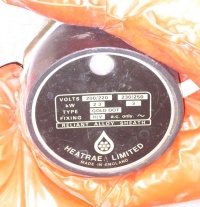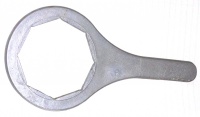Difference between revisions of "Immersion Heaters"
m (→Replacement: Changed link to point directly at immersion heater spanners rather than general spanner page) |
(→Replacement: link) |
||
| Line 117: | Line 117: | ||
When removing an old element, the tank should be kept full of water while loosening the element to discourage the tank from crumpling. Loosen the heater with an immersion heater [[Spanner#Immersion_heater_spanners|spanner]]. Its more effective to tap it with a hammer than rotate it by hand. If very stiff, turning it slightly both ways sometimes helps. Once its moving a bit freer the tank can be drained to below the level of the heater. | When removing an old element, the tank should be kept full of water while loosening the element to discourage the tank from crumpling. Loosen the heater with an immersion heater [[Spanner#Immersion_heater_spanners|spanner]]. Its more effective to tap it with a hammer than rotate it by hand. If very stiff, turning it slightly both ways sometimes helps. Once its moving a bit freer the tank can be drained to below the level of the heater. | ||
| + | |||
| + | [https://groups.google.com/group/uk.d-i-y/browse_frm/thread/21c2ff7b819e3222?hl=en# Rather more info] | ||
==See Also== | ==See Also== | ||
Revision as of 05:41, 10 February 2012
Electric immersion heaters are a popular choice where a gas supply is not present. Gas water heating usually has lower run cost.
How they Work
- There is a jacketed heating element in the water tank.
- Usually the element has a built in adjustable thermostat, but there are also some with no stat built in, and a separate external stat attached to the tank, usually at about 1/3 the way up the tank.
- There is an on/off switch (or occasionally a timer) on the supply to the heater.
- Newer elements also have a secondary thermal cutout built in
2 Element Systems
This variant has a small upper element to give a relatively small volume of hot water which heats faster, as well as the main longer element that produces enough for a shower or bath.
Economy 7 Systems
Dual tariff systems typically heat the lower element at night, and use the smaller top element for top-up heat in the day.
Element Size
27" elements heat the whole tank. This is the most common size.
11" elements are used for top heat only, and for whole tank heating with Fortic tanks.
14", 18" 30" and 36" elements are also available, but are less common than 11" & 27". The element should generally be 3" - 6" shorter than the max length fittable.
Faults
The majority of faults can be found by testing just 3 resistances:
- across the 2 heating element terminals
- should be somewhere vaguely in the region of 20 ohms, but can vary a fair bit.
- across the 2 thermostat terminals
- should be far below 1 ohm when cold.
- From heating element terminals to casing.
- should be open circuit.
Insulation Breakdown
This common fault causes current to flow from live to earth in the element. This causes 3 problems:
- current flow is increased, which can sometimes cause fuse blowing, MCB tripping or burnt accessories
- A tripping MCB may prevent it starting.
- RCD will trip if its on an RCD protected power feed
This fault can be detected by measuring resistance between element connections and its casing.
The only solution is to replace the element.
Split Element
Elements often split open during the last phase of their life. Rapid corrosion of the resistance wire then occurs, breaking the element circuit. However the element continues to operate for a fair time by conducting through the water.
Despite what we were taught about electricity and water as children, this condition does not cause any deaths or injuries in the UK, and is a widespread occurrence. In fact the principle of feeding mains electricity direct through the water is standard practice in industry, albeit with a bit more precaution than is applied to domestic hot water. It is known as electrode heating.
In this phase of life,
- resistance testing from element terminals to casing shows low resistance
- Heating may be faster or slower than usual due to less well controlled current
- Element may cycle on & off due to excess heating
- A heater on an RCDed feed will trip the RCD immediately.
The only solution is to replace the element.
Burnt thermostat
Burning of the thermostat connections is another common failure, and results in failure to function. Parts of the stat may be burnt to charcoal.
To test for this, resistance test across the thermostat connections. R should be a small fraction of an ohm with a cold element. If higher, the stat contacts are damaged.
If this occurs, the possible solutions are:
- Replace element & thermostat in one
- Replace thermostat only, if possible
- File the contacts clean and check the temp setting afterwards
- It used to be compliant to wire across the built-in stat and add an external 13A rated stat strapped to the tank, but this no longer meets the requirement for a secondary non-resettable thermal cutout.
Either way one should clean out all traces of carbon deposits. The tiniest amounts left behind can cause electrical problems.
Burning or Fishy Smell
May be due to burning or cooking of the thermostat, the FCU or an end of the flexible cable. Inspection should show any discoloured and burnt material.
The solution is to replace the burnt part, and if the cable end is not clean & bright, cut it back several inches to where it is and reconnect.
This problem is sometimes caused by a split element consuming above rated current, so its a good idea to check the element resistances as well.
Not enough hot water
This is caused by any of:
- thermostat set too low. This can be a problem with new replacement elements, which often have stats that wont go as high as older ones, but sometimes the tank size can require a higher temp to have enough HW capacity.
- replacement element too short
- For curved element systems, replacement element is mounted the wrong way up, with the curved end pointing up instead of down
- For 2 element systems, bottom element not working
- With heat banks, a badly scaled exchanger reduces rate of heat throughput, but not capacity. The tell tale sign is that fast flowing HW is not hot enough, but slow the flow down and the temperature is restored.
- Insufficient HW system capacity for new appliances, eg power shower
Solutions:
- Turn up stat. If it won't go high enough, it may be possible to wire it out of circuit and replace with an external stat, but a secondary non-resetting temperature cutout is also now mandated.
- Replace the replacement element with the correct longer size
- Refit element with curved end down
- Troubleshoot lower element & its associated parts
- Replace or descale exchanger. Consider scale prevention before the exchanger.
- Applying as many options in Increase Hot Water Capacity as possible may be enough. Turn down shower pumping rate. If these measures aren't enough, a larger HW cylinder will be needed.
See also Increase Hot Water Capacity for more options.
Recommendations
It is not recommended to put an immersion heater on a ring circuit.
It is not recommended to put an immersion heater on a 13A plug.
Elements that expand and shrink slightly will shed scale build-up, and last much better in hard water areas.
Replacement
When removing an old element, the tank should be kept full of water while loosening the element to discourage the tank from crumpling. Loosen the heater with an immersion heater spanner. Its more effective to tap it with a hammer than rotate it by hand. If very stiff, turning it slightly both ways sometimes helps. Once its moving a bit freer the tank can be drained to below the level of the heater.

